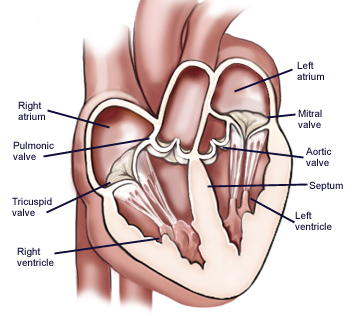As your heart pumps blood, four valves open and close to make sure blood flows in the correct direction. As they open and close, they make two sounds that create the sound of a heartbeat. The four valves are the aortic valve, mitral valve, pulmonary valve and tricuspid valve. A heart murmur is often the first sign of a heart valve problem.
Advertisement
Cleveland Clinic is a non-profit academic medical center. Advertising on our site helps support our mission. We do not endorse non-Cleveland Clinic products or services. Policy

Your heart is a muscle that pumps blood throughout your body. Heart valves are parts of your heart that act like doors. They open and close to let blood flow from one area of your heart to another. They help ensure that blood moves at the right time and in the correct direction. As the valves open and close, they create two sounds, which are your heartbeat.
Advertisement
Cleveland Clinic is a non-profit academic medical center. Advertising on our site helps support our mission. We do not endorse non-Cleveland Clinic products or services. Policy
The four valves of the heart are:
A healthy heart transports blood in a predictable route through four chambers. The four chambers are the left and right atria on the top of your heart and the left and right ventricles on the bottom.
Between chambers, there are valves, which are made of thin but strong flaps of tissue. They’re called leaflets or cusps. The valves open and close to help blood move along its path:
Each valve has a specific location, structure and job:
Advertisement
If a heart valve doesn’t work correctly, your heart might have to work harder to pump blood.
Heart valve problems can be related to:
There are three main types of heart valve problems. Each type of problem can happen in any of the four valves:
Some people can have a heart valve condition but not have any symptoms at all. Heart valve conditions tend to get worse over time, so symptoms may appear as a person gets older.
The sound of your heartbeat is the sound of your heart valves opening and closing. The first sign of a heart valve problem is often a heart murmur (an unusual sound when your heart beats). However, a heart murmur can happen even when there are no valve problems. This is called an innocent heart murmur.
Other signs and symptoms of a heart valve problem may include:
If you have a heart valve condition, you can help keep your heart healthier and prevent complications with these strategies:
If you have a heart valve problem, you should be cautious about endocarditis (heart infections). Call your healthcare provider right away if you have signs of infection, including body aches, fever or sore throat.
Your heart contains four valves that open and close to control the flow of blood through it. The valves can become damaged by age, infection or other chronic conditions, and some people are born with heart valve defects. A heart murmur is often the first sign of a heart valve problem, even before symptoms start. Have regular checkups to make sure your heart and its valves are functioning well.
Advertisement
It can be scary and overwhelming when something is happening with your heart valves. Cleveland Clinic heart specialists are ready to get you the help you need.

Last reviewed on 05/14/2022.
Learn more about the Health Library and our editorial process.